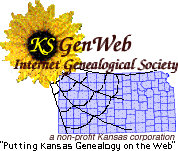Reno County KSGenWeb Project |
Reno County KSGenWeb Project |
|
Sweeping Boxcars for Wheat starting in the early 1940's Written and submitted by Phillip Harrison Pitzer My money making career started about the time I was five years old. I was raised on the south side of the Santa Fe Railway tracks in east Hutchinson, Reno County, Kansas. Just across the tracks on the north side was the Grain Belt Elevator where I learned from my older brothers John, Jim, and Clarence, how to sweep wheat in box cars which were emptied of their cargo of recently harvested Kansas wheat. The Gain Belt Elevator was a regional terminal where outlaying smaller communities would ship via railroad their recent harvested wheat. When a boxcar was unloaded, there always was a little wheat left on the floor of the boxcar. This was where he opportunity for an entrepreneur came in. Being poor and not having other things to occupy our time, my brothers and I engaged in sweeping out these boxcars. We would collect what wheat we could as the cars were unloaded. All the capitol investment that was required was a broom and a sack. We worked as a team so only one broom and probably one sack was all that we required for anyone day. Our family had chickens along with other animals, such as pigeons, rabbits, goats, etc. We sweep wheat to serve our own animals first, but there was many neighbors in the neighborhood who would pay handsomely for our surplus wheat supply. You have to understand this was during the World War II, and everyone where I lived was poor and did many things to keep the family going. So my first introduction into the wonderful world capitalism was work hard and you can find your niche in the life you were born into. As I remember we did not make a lot of money, but in those days every nickel and dime you had meant you could go to grocery store and buy candy or ice cream like other kids. I have to tell you living next to The Grain Belt Elevator during the War was one of greatest things that could ever have happen to a poor young kid like myself. To tell you the truth, and it maybe hard to believe, but those folks who ran the Elevator were very kind to us and let us do things that most kids never got to do. It scares me today to remember that as boy of only five or six these men would take my brothers and me on tours all over the Elevator. The concrete tanks were one hundred feet tall and we would go up the man lift and walk out on the top of these tanks. there was no railing or protection to keep one from falling over the edge. I never did do this, but my older brothers would set on the edge of the tanks (one hundred feet in the air) and dangle their feet over the side. I do not know if you know what a "MAN LIFT" is or not, but that is the system by which one rode up or down from the bottom to the top of the elevator. It was a large continuous belt that had small platforms or step bolted every so often with a handle bolted to the belt some distance from the step, so a full grown person could stand on the step and hang on the handle and ride to the top or bottom, which ever way you were going. Well, even though I was big for my age, I was too short to stand on the step and reach the handle. When I rode the man lift I would have to wait till a full grown person was going my way and I would stand in front of them for protection so I would not fall off the man lift. All the years I was around the elevator I never was hurt or had an accident, only by the grace of God. After the War in 1945, the railroad frowned upon anyone sweeping wheat in their boxcars, so that endeavor came to a close after about 1945. This income was good only for a few months in the summer. |
Return to Pitzer Index Return to RenoCoKS Main Page
 |
Copyright 2010 - present by the KSGenWeb Team. All rights reserved. Copyright of submitted items belongs to those responsible for their authorship or creation unless otherwise assigned. |
 |